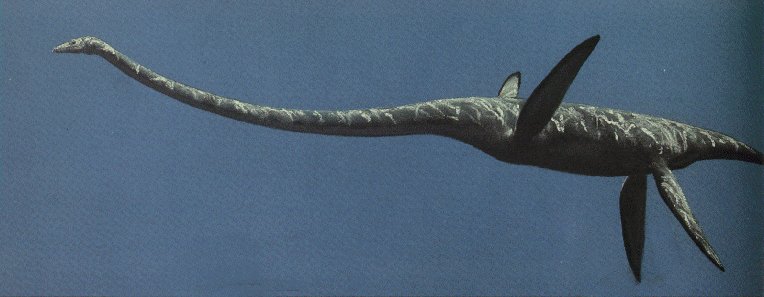
Gastroliths from the Coal Oil Canyon Plesiosaur (NJSM 15435)
Copyright © 2000-2012 by Mike Everhart
Last revised 05/09/2012
LEFT:Adapted from a painting by Doug Henderson. Copyright © Doug Henderson; used with permission of Doug Henderson
 |
Gastroliths from the Coal Oil Canyon Plesiosaur (NJSM 15435) Copyright © 2000-2012 by Mike EverhartLast revised 05/09/2012LEFT:Adapted from a painting by Doug Henderson. Copyright © Doug Henderson; used with permission of Doug Henderson |
![]()
Gastroliths or 'stomach stones' have been associated with a variety of fossil specimens, but probably no where as consistently as with the long necked plesiosaurs. While their function is still uncertain, it is a fact that plesiosaurs were swallowing these stones in large numbers. Some specimens have been found with as many as 250 or more gastroliths in the abdominal area. It has been proposed that these stones were ingested to help in grinding up their food or to provide ballast the assist the animal while swimming, or were simply swallowed accidentally while feeding on bottom dwelling prey. The source of these stones, however, is almost never near where the animal died, and most of the time is hundreds of miles away. This indicates that that the plesiosaur may have traveled long distances while it was alive to the stream bed or sea shore where these rounded pebbles originated.
Later that year, Mudge and his assistant, S. W. Williston, collected part of a large plesiosaur (YPM 1644 ? - Styxosaurus snowii) from the Smoky Hill Chalk in Gove County, Kansas. This was apparently the first time that Mudge had seen gastroliths in association with plesiosaur remains. Williston, 1906, p. 232-3) said that "It was the first specimen of a plesiosaur that I ever saw." Mudge (1877) noted that "in the Plesiosauri, we found another interesting feature, showing an aid to digestion similar to many living reptiles and some birds. This consisted of well-worn siliceous pebbles, from one-fourth to one-half inch in diameter. They were the more curious, as we never found such pebbles in the chalk or shales of the Niobrara. How far the Saurians wandered to collect them is a perplexing problem." In his discussion of Elasmosaurus platyurus, Williston (1906, p. 226-227) noted that, "It was with a specimen of an elasmosaur (E. snowii) that Mudge first noticed the occurrence of the peculiar siliceous pebbles which he described; and it was also with another, a large species yet unnamed, from the Benton Cretaceous, that the like specimens were found described by me in 1892. That this habit was not confined to this type of plesiosaur, however, is certain, since I have also observed it in different species of Polycotylus and Trinacromerum." (See Williston, 1893)
 |
The Coal Oil Canyon specimen was no exception. In this case, however, there were also fish bones and scales mixed with the gastroliths, making this specimen one of a half dozen or so plesiosaurs preserved with stomach contents. (Styxosaurus snowii, middle Campanian, Upper Sharon Springs Member, Pierre Shale Formation, Logan County, KS) |
While on the Coal Oil Canyon plesiosaur dig in 1991-92, I took notes in a small pocket notebook and then transferred the notes to my field book each evening. The pages from the pocket notebook are: njnotes1, njnotes 2, njnotes3, njnotes4, njnotes5 and njnotes6. (1991 = 1-4; 1992 = 5 and 6). The pages from the field book are: page1, page2, page3, and page4 (all from 1991). In addition I filmed the dig with a video camera and took pictures with a 35 mm camera. Pictures which show some aspects of the gastroliths or the stomach contents are shown below:
NOTE: Clickable links to pictures are in blue
![]()
 |
The initial exposure of ribs in the upper abdomen, just behind the coracoids. Orange tape marks the location of a gastrolith that is not visible in this picture. Note location of ribs in lower left as markers for the following pictures. |
 |
Looking toward the north-northeast parallel with the concretion containing many of the dorsal vertebrae. The first gastroliths found are visible in this picture. Note same tape and ribs as in first picture. |
 |
Looking north at center of 'stomach contents'. Large gastrolith at left is the primary 'marker stone'. Scale is a meter stick. |
 |
Again, looking to the north-northwest, parallel to dorsal vertebrae in concretion. |
 |
Looking to the west, with left (?) front paddle in the foreground, and a good view of gastroliths starting immediately behind left(?) coracoid. Note location of the 'marker stone' seen in picture 3. |
 |
Looking to the north, at one of the rear paddles (above meter stick) and part of the pelvis. There are two outlying gastroliths in the upper right corner of the picture. |
 |
A close-up of two of the gastroliths found with this specimen. |
  |
There were gastroliths mixed with plesiosaur bones (ribs and gastralia) in the abdominal area of the specimen. This area was also stained rust red and contained fish bones, vertebrae and scales. |
  |
The gastroliths were surrounded by a 'hash' of tiny pieces of fish bone, suggesting that the gastroliths may have had some role in helping the plesiosaur digest its prey. |
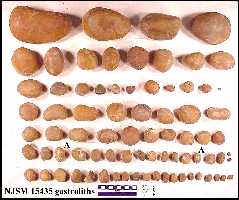 |
In 2002, I traveled to the New Jersey State Museum in Trenton, New Jersey and had an opportunity to photograph the complete set of gastroliths from the NJSM 15435 specimen for the first time. The picture at right shows the extreme range of sizes of gastroliths encountered in the stomach contents of this elasmosaur. Note the size of the smallest stone found on the right end of the 3rd row. The two gastroliths marked (A) appear to be agates. Click HERE for a closer view of these two stones. The red-orange coloring of the gastroliths is due to surface staining by iron oxides. |
Additional pictures of this dig are located at: 1991 dig page and 1992 dig page.
![]()
Gastroliths from other specimens from the Western Interior Seaway.
 |
Most of the 47 unusually large gastroliths from a partial elasmosaur skeleton found by Pete Bussen and dug by staff of the Natural History Museum at the University of Kansas (KUVP-129744) in 1991 in Logan County, Kansas. The dig on the remains was completed by the Cincinnati Museum in 1998. |
 |
The heaviest of the gastroliths in this specimen, this rounded stone weighed 1490 g (3.3 pounds) and was 129 mm (5 inches) long. |
 |
The longest of the stones was 170 mm (6.7 inches) in length and weighed 1320 g (2.9 lb.). The total weight of the gastroliths in this specimen was over 13 kg or 29 lbs. |
 |
Three more "probable" gastroliths found at the dig site in 1994. Since there were less than 50 gastroliths found in situ with this dis-articulated specimen, it is likely that many more of the stones had eroded out years ago, or were lost from the carcass before burial. |
  |
An unusual specimen (KUVP-68979) in the Natural History Museum at the University of Kansas. First reported by Moodie (1912), this specimen consists of 41 vertebrae of a large shark (Cretoxyrhina mantelli) mixed with more than 120 mostly black, well polished 'chert' gastroliths. It is likely that the shark fed on a plesiosaur shortly before it died, leaving the indigestible gastroliths mixed with it's own cartilaginous vertebrae. |
 |
A closer view of the vertebrae and gastroliths. Based on the size of these vertebrae, the shark would have been between 5 and 6 meters in length when alive (Shimada, 1997). |
  |
An extreme close up of one vertebra and associated black 'chert' gastroliths. This specimen was also discussed by Shimada (1997) as evidence of Cretoxyrhina mantelli feeding on plesiosaurs. The second picture shows another detail from the area near the middle of the specimen, showing the many small gastroliths that were mixed in with the larger sizes. |
  |
A collection of about 88 gastroliths that were found associated with Kansas plesiosaur material (KUVP 1318) and originally described by S.W. Williston in 1903. The second picture (left) is a closer look at some of the larger stones from KUVP 1318. The scale is 6 inches (15 cm) and the largest stones are just over 60 mm in length. Many of the stones were mottled gray in color and obviously came from the same source. |
 |
One of the front paddles of the plesiosaur (Alzadasaurus = Styxosaurus) described by Darby and Ojakangas (1980). Some of the 197 gastroliths associated with this specimen are visible in the center of the picture. |
  |
Looking at the same paddle, with a broken propodial in the fore ground. Gastroliths are visible to the left of the rock hammer. Children added for scale. The second picture is the pile of 'rocks' found associated with this plesiosaur (8.8 kg - 19.4 pounds). The largest stones were about 11 cm (4.3 inches) long. |
  |
A few of the 253 gastroliths reported from a specimen of Styxosaurus snowii (Alzadasaurus pembertoni, SDSMT-451) in the collection of the South Dakota School of Mines. This elasmosaur was recovered from the Pierre Shale in 1945 and is about 36' long. It was described by Welles and Bump (1949). Largest stone in this photograph is about 6 cm long. |
  |
Some of the 'thousands' of small gastroliths associated with an elasmosaur specimen found on Vega Island off the coast of Antarctica in February, 1999. The largest stone in this picture is about 5 cm in length. Most are less than a cm in length. This collection is currently on display at the Museum of Geology (South Dakota School of Mines and Technology). |
 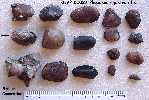 |
These gastroliths were found in association with plesiosaur bones (KUVP 50027) from a concretion in the Pierre Shale formation in South Dakota. The larger mass on the left contains at least six gastroliths and piece of plesiosaur rib bone. (Museum of Natural History, University of Kansas) |
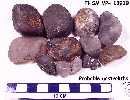 |
A collection of probable 'gastroliths' (FHSM VP-13919) from the lower (late Coniacian) Smoky Hill Chalk, Gove County, Kansas. These stones were not associated with any vertebrate remains, so their identification as gastroliths is conjectural. They appear to be quartzite, a mineral which is not found in the chalk. It is possible that they spilled from the abdomen of a floating carcass of a plesiosaur that was being fed upon by scavengers. (A closer view is HERE) |
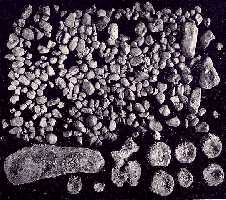 |
The picture at left was published in Williston (1903) - North American Plesiosaurs - and shows the more than 200 gastroliths associated with a plesiosaur called Plesiosaurus mudgei (KUVP 1305) from the Lower Cretaceous (Albian) Kiowa Shale, Clark Co., KS. It was collected by C. N. Gould in 1893 and named by Cragin. |
For more information on gastroliths in general, see Oliver Wings' Gastrolith Page
Suggested Reading on Gastroliths:
Brown, B. 1904. Stomach stones and the food of Plesiosaurs. Science 20(501):184-185.Cicimurri, D. J. and M. J. Everhart. 2001. An elasmosaur with stomach contents and gastroliths from the Pierre Shale (late Cretaceous) of Kansas. Kansas Acad. Sci. Trans 104(3-4):129-143.
Cragin, F. W. 1894. Vertebrata from the Neocomian of Kansas. Colorado College Studies v pp. 69-73, pls. i, ii.
Cutler, W. G. 1883. History of the State of Kansas. A. T. Andreas, Chicago, IL.
Darby, D. G., and R. W. Ojakangas. 1980. Gastroliths from an Upper Cretaceous plesiosaur. J. Paleon. 54(3):548-556.
Everhart, M. J. 2000. Gastroliths associated with plesiosaur remains in the Sharon Springs Member of the Pierre Shale (Late Cretaceous), Western Kansas. Kansas Acad. Sci. Trans. 103(1-2):58-69.
Everhart, M. J. 2002. Where the Elasmosaurs roam...... Prehistoric Times. 53:24-27.
Everhart, M. J. 2004. Conchoidal fractures preserved on elasmosaur gastroliths are evidence of use in processing food. Journal of Vertebrate Paleontology 24 (Supplement to 3): 56A.
Everhart, Michael J. 2005. Oceans of Kansas - A Natural History of the Western
Interior Sea. Indiana University Press, 320 pp.
Everhart, M.J. 2005. Probable plesiosaur gastroliths from the basal Kiowa Shale (Early
Cretaceous) of Kiowa County, Kansas. Kansas Academy of Science, Transactions 108 (3/4):
109-115.
Everhart, M. J. 2005. Elasmosaurid remains from the Pierre Shale (Upper Cretaceous) of
western Kansas. Possible missing elements of the type specimen of Elasmosaurus platyurus
Cope 1868? PalArch 4(3): 19-32.
Gillette, D. 1990. Seismosaurus: The Earth Shaker. Columbia University Press, New York, 205 pp.
Henderson, D.M. 2006. Floating point: a computational study of buoyancy, equilibrium, and gastroliths in plesiosaurs. Lethaia 39:227-244.
Kubo, T., Mitchell, M.T. and Henderson, D.M. 2012. Albertonectes vanderveldei, a new elasmosaur (Reptilia, Sauropterygia) from the Upper Cretaceous of Alberta. Journal of Vertebrate Paleontology 32(3):557-572.
Moodie, R. L. 1912. The stomach stones of reptiles. Science (New Ser.) 35(897):377-378
Mudge, B. F. 1877. Notes on the Tertiary and Cretaceous periods of Kansas. pp. 277-294, in Part I (Geology) of the Ninth Annual Report, U. S. Geol. and Geo. Surv. Terr. (Hayden), for 1875, 827 p.
Riggs, E. S. 1939. A specimen of Elasmosaurus serpentinus. Field Museum of Natural History, Geology 4:385-391.
Schmeisser,
R.L. and Gillette, D.D. 2009. Unusual
occurrence of gastroliths in a polycotylid plesiosaur from the Upper Cretaceous Tropic
Shale, southern
Shimada, K. 1997. Paleoecological relationships of the Late Cretaceous lamniform shark, Cretoxyrhina mantelli (Agassiz). J. Paleon. 71(5):926-933.
Shimada, K., Tsuihiji, T., Sato, T. and Hasegawa, Y. 2010. A remarkable case of a shark-bitten elasmosaurid plesiosaur. Journal of Vertebrate Paleontology 30(2):592-597.
Storrs, G. W. 1999. An examination of plesiosauria (Diapsida: Sauropterygia) from the Niobrara Chalk (upper Cretaceous) of central North America. The University of Kansas Paleontological Contributions (New Ser.), No. 11, 15 pp.
Taylor, M. A. 1981. Plesiosaurs - rigging and ballasting. Nature 290:628-629.
Taylor, M. A. 1993. Stomach stones for feeding or buoyancy? The occurrence and function of gastroliths in marine tetrapods. Phil. Trans. R. Soc. Lond. B 341:163-175.
Taylor, M. A. 1994. Stone, bone or blubber? Buoyancy control strategies in aquatic tetrapods. in Mechanics and physiology of animal swimming. Maddock, L, Bone, Q. And Rayner, J. M. V. (eds.), Cambridge University Press, pp. 205-229.
Thompson, W. A., Martin, J. E. and Reguero, M. 2007. Comparison of gastroliths within plesiosaurs (Elasmosauridae) from the Late Cretaceous marine deposits of Vega Island, Antarctic Peninsula, and the Missouri River area, South Dakota. Pages 147-153 in Martin, J. E. and Parris D. C. (eds.), The Geology and Paleontology of the Late Cretaceous Marine Deposits of the Dakotas. Geological Society of America, Special Paper 427.
Welles, S. P. and J. Bump. 1949. Alzadasaurus pembertoni, a new elasmosaur from the Upper Cretaceous of South Dakota. J. Paleon. 23(5):521-535.
Whittle, C. H. and M. J. Everhart. 2000. Apparent and implied evolutionary trends in lithophagic vertebrates from New Mexico and elsewhere, pages 75-82, In Lucas, S. G. and A. B. Heckert, (eds.), Dinosaurs of New Mexico, New Mexico Museum of Natural History and Science Bulletin 17.
Wiffen, J. and W. L. Moisley. 1986. Late Cretaceous reptiles (Families Elasmosauridae and Pliosauridae) from the Mangahouanga Stream, North Island, New Zealand, New Zealand Journal of Geology and Geophysics, 29:205-252.
Williston, S. W. 1893. An interesting food habit of the plesiosaurs. Trans. Kansas Acad. Sci., 13:121-122, 1 plate. (Gastroliths)
Williston, S. W. 1894. A food habit of the plesiosaurs. The American Naturalist 28(325):50. (Gastroliths)
Williston, S. W. 1904. The stomach stones of the plesiosaurs. Science (new series) 22:565.
Williston, S. W. 1906. North American plesiosaurs: Elasmosaurus, Cimoliasaurus, and Polycotylus. American Journal of Science 4(21):221-236.
Williston, S. W. 1914. Water reptiles of the past and present. Chicago Univ. Press. 251 pp. (Free, downloadable .pdf version by the Arment Biological Press)
OTHER PLESIOSAUR INFORMATION:
Where the elasmosaurs roam.... Prehistoric Times (#53, April, 2002)
"We Dug Plesiosaurs" - with the Cincinnati Museum in 1998
The 1999 Cincinnati Museum Plesiosaur Dig
Plesiosaur References: A listing of publications related to plesiosaurs
A list of references in my library about mosasaurs and plesiosaurs
Also, you can visit Ray Ancog's Plesiosaur FAQ Page (Frequently Asked Questions)
Plesiosauria Translation and Pronunciation Guide
Barry Kazmer's Plesiosaur Paleontology Page